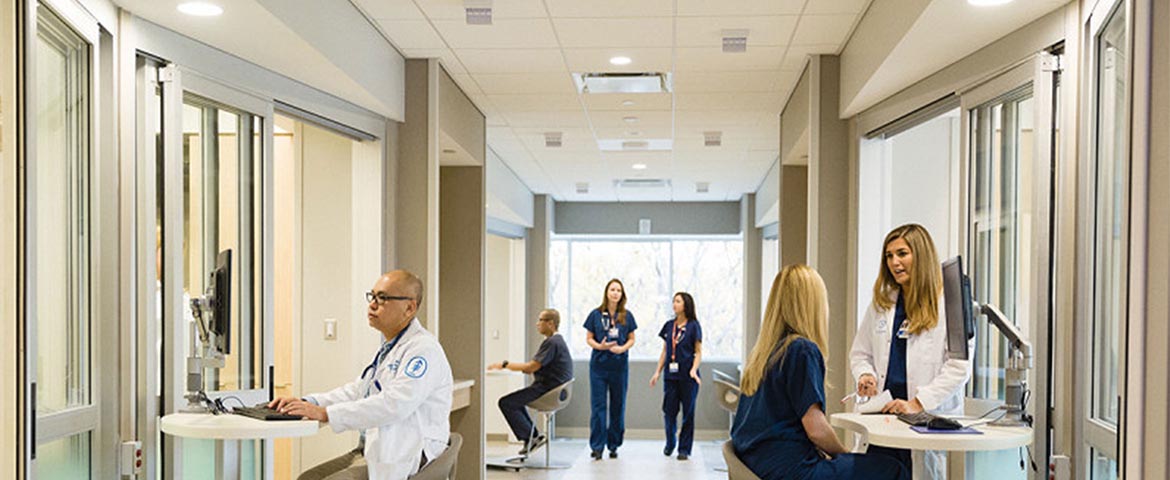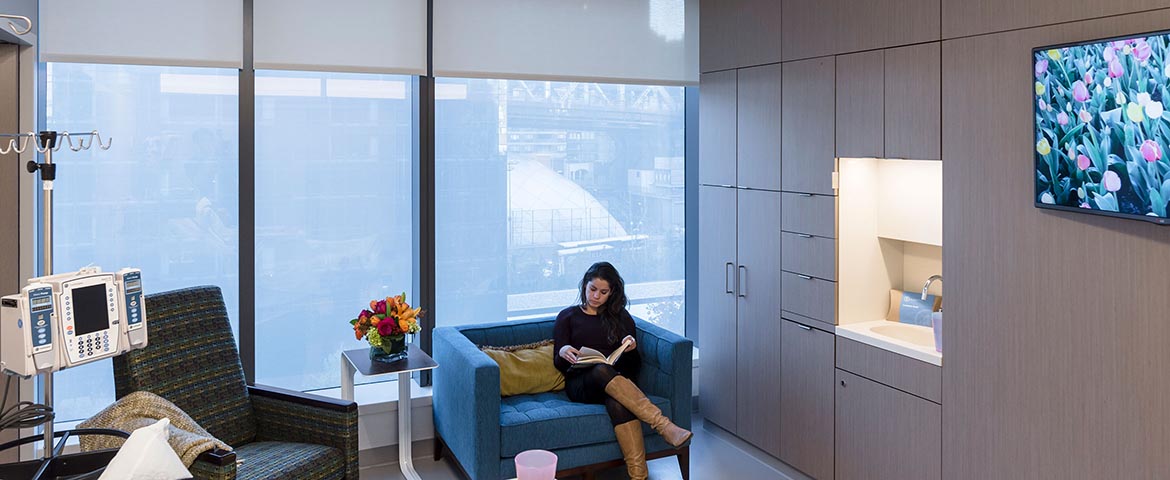11 Lighting Design Considerations for a Hospital
The lighting system you specify plays a key role in the day-to-day hospital setting, but also in the patient’s healing process. Proper illumination is important for everyone in a hospital. Lighting affects a person’s experience from the moment they enter the hospital, including task- and treatment-oriented lighting, patient and occupant comfort, and staff alertness. Specifying the right lighting solution can improve patient experience, optimize patient-centric care, and provide the infrastructure required for additional future capabilities. These outcomes directly influence a hospital’s ratings. High patient experience ratings equate to an increase in revenue. Both in terms of design and technology, your lighting controls specification makes a difference in patient and staff experience as well as the success of the hospital.Lighting Design Considerations
Here’s what you can accomplish in the space from a lighting design perspective:
1. Think Building Aesthetics
When a person walks into a hospital lobby is the first moment lighting design is experienced. A well-lit lobby focused on radiating a welcoming, accommodating, and comfortable environment is indicative of what they can anticipate their experience will be. Maximizing daylight in a hospital enhances the interior aesthetics, putting everyone at ease and preparing for whatever the day ahead holds for them.
Specifying Tips:
- Network the lighting controls to provide different “after hours” settings.
- Use photosensors to reduce electric light and maximize daylight.
- Choose motorized shades for easy automation.
2. Build Energy Efficiency into Public Areas
As important as the first impression is the energy savings that harnessing sunlight does for a hospital. Hospitals operate 24/7. With lighting being a huge expense, access to natural light in combination with time-of-day controls minimizes energy consumption when daylight is available and impacts the hospital’s bottom line.
Specifying Tips:
- Network the lighting controls for much of the facility to provide different “after hours” settings.
- Use occupancy/vacancy sensors throughout to turn lights off when a space is unoccupied.
- Add motorized shades and create daily and yearly scheduled scenes to maximize seasonal daylight while addressing glare and other uncomfortable natural light scenarios.
3. Incorporate Shade Control into Lighting Controls
Beyond energy savings, comfort, and aesthetics, combining automated shading controls into your lighting control system allows for single interface control and ease of use. Most shades are incorporated into lobby and patient room design, where comfort, privacy, and glare control are factors. They are also effective against exterior heat gain from direct sunlight exposure.
Specifying Tip:
- Consolidate manufacturers where system integrations are common, such as lighting and shading, to eliminate integration issues and headaches during startup/commissioning.
4. Give Control of Lighting to Patients and Staff
Control of the shades and lighting is paramount in patient rooms, not only for occupant and patient comfort, but to afford flexibility in a space where various tasks are performed. Different lighting levels are more desirable for caregivers and visitors than when the patient is resting and healing. Treatment and examination lighting require different levels than those for occupant comfort. Integrating shade and lighting controls makes for a seamless and simplified experience for all moments of room occupation. Of note, specifying a screen interface, such as a tablet, versus a pillow speaker for light control further enhances the patient’s experience because of ease of understanding and use.
Thoughtful design of lighting environment and controls directly affect medical staff ability to do their job, as well as contribute to job satisfaction. A study by Hadi et al (2015) showed that lighting conditions at patient bedside and decentralized nurse stations were significantly less desirable for nurses compared to other locations. Ultimately, nurses’ satisfaction with lighting directly correlated to their access to the controls, in this case dimmers and switches. Designing controls to be clearly marked and having zoned override switches for critical tasks takes the guesswork out of changing the lighting for the task at hand. A well-known example of this is having a large, obvious code blue switch in the same location in all patient rooms. The mechanics and timing of getting to the switch and turning it on is negligible in an emergency. Further, automating adjustment of light level, where able allow staff to focus on patient care instead of the environment (e.g., changing from night illumination levels to exam levels in patient rooms).
Specifying Tips:
- Specify a patient tablet interface for ease of use.
- Network all patient rooms for time-of-day scheduling (e.g., lights only turn on to 50% output during nighttime hours).
- Ensure the ability to program or troubleshoot a room remotely and not interfere with a patient.
- Specify a motorized shading solution that can be manually pulled into position by the patient or staff. This allows for damage-free shades and permits control of shades without knowing the controls interface.
5. Adjust Light Intensity Properly to Increase Productivity
Exposure to proper illumination through a specific lighting schedule can reduce the feeling of stress and burnout for staff in a high pace 24/7 hospital. Long hours and overnight shifts in dim light conditions can make care and decision making more difficult. Tailoring light for medical staff enhances productivity and performance. Nurses and care providers can comfortably check on patients and read equipment at any time of day or night. They can also comfortably perform critical tasks such as dispensing medication and monitoring vitals.
Specifying Tip:
- Select a system with multiple user interface options to let staff decide which is relevant and easy to use for their use case.
6. Use the Right Color Temperature for Examinations Rooms
Light color is arguably most important for examinations. Emergency rooms and neonatal units are two examples of how having the right color light aids in examinations and diagnoses. Color tuning enables the physician or nurse to use the correct color light for examinations. For example, in a neonatal unit, medical staff may have difficulty diagnosing jaundice if the light color is too yellow, which is typically identified by a yellowing of the skin and eyes. Tuning the light to daylight colors with more blue are best for these types of situations.
Specifying Tips:
- Ensure the delivered color temperature is within 3 MacAdam ellipse (MAE) of the desired color
- Ensure the spectral power distribution (SPD) at each color temperature meets the customer’s needs
- Select a system that does not require extra programming to achieve the desired MAE and SPD requirements.
7. Design for Infection Control Procedures in Mind
Using auto-on occupancy sensors to turn lights on in examination rooms assists in reducing the risk for infection transmission – eliminating the need to touch. Moreover, the lighting control system can inform or update infection control procedures and timing where UVC light is used to disinfect a room. Direct UVC exposure to human skin or eyes may cause injuries, so the occupancy sensors can signal to turn off the UVC light source if it senses a person in the room.
Specifying Tip:
- Specify a lighting solution that not only provides effective illumination, but also upholds stringent infection control standards and supports strict cleaning protocols.
Technical Considerations
Technology can create a seamless patient experience, improve communication, and improve patient care. These tech considerations will help set your client up for success and keep your design from becoming obsolete:8. Building System Integration
Hospital building controls systems are constantly taking on more systems as applications evolve that use integration to lower cost, improve performance, and elevate patient experience. Integrating lighting control systems allows for energy usage management of major building systems such as HVAC and lighting, improved operational efficiency resulting in building wide device visibility (aka asset tracking), flagging, and servicing, for example, and collection of building performance data. Interpreting the data collected helps identify trends, which can be the catalyst for changes in programming, proactive maintenance, and problem identification.
Specifying Tips:
- Select a system that is backed by a services organization that can help make the building’s data actionable.
- Select a system that enables unobstructed access to the building’s data.
9. Keep Controls Simple
With many options in light levels, colors, fixtures, keep it simple with the controls. Simplicity in controls is best for user experience and for budget. Mixing and matching different dimming control types creates more complexity from design to installation, which increases cost. The burden also lies with the facilities management team, tasked with keeping everything working around the clock, and the end user. Remember the nurses and other care providers particularly as they are the ones who occupy multiple areas of a hospital. More variations in controls means they must learn and remember what is different where. Stick with one dimming controller type when possible. Use your lighting controls expert to help design and layout a cost-effective solution.
Specifying Tip:
- Specify switch button engraving and an aesthetic that is intuitive for the user.
10. Future-Proof the Patient Room
This is an era of rapid change with technological pressures meeting financial pressures. An adaptable and flexible design helps future-proof a hospital. When determining layout, give the facility design flexibility to add more features and functions in the future without having to retire and replace what has already been purchased. Patient comfort integrations with a networked lighting control system make adding features easier such as pillow speakers that help the patient communicate with the nurses' station and control lighting and shades in their room to bedside tablet interfaces that allow the patient to control not just lighting and shading but also the temperature. Specify a platform that allows the facility to expand its uses in the future.
Specifying Tip:
- Digital Lighting Management (DLM) is a digital platform that is expandible and allows you to add existing systems, such as Luminaire-level lighting control (LLLC), new systems, and integrate with other manufacturers.
11. Secure the Systems
With the recent spate of hackers holding hospitals confidential data hostage, system security is of the utmost importance. The convenience and savings derived from integrating building systems with networked lighting controls creates another opportunity for you to secure your specification. Mitigate security risk by addressing possible issues through understanding the techniques that help meet cybersecurity requirements for your hospital projects.
Specifying Tips:
- Specify networked lighting controls that are qualified through reputable third-party organizations such as the ioXt Alliance.
- Ensure your system is easy to upgrade to protect against future threats.
Control, consistency, flexibility, support, and energy efficiency are foundational to hospital lighting specification. With patient comfort and staff productivity and alertness at the forefront of design coupled with quickly evolving technology, this list begins to help you understand the importance of proper illumination and control in a hospital setting. Working with a reputable lighting controls team can help you navigate all the intricacies of hospital specification and assist you in layout.
References
Hadi, Khatereh, et al. “Lighting and Nurses at Medical–Surgical Units.” HERD: Health Environments Research & Design Journal, vol. 9, no. 3, 2015, pp. 17–30., https://doi.org/10.1177/1937586715603194.
Joseph, Anjali. “Impact of Light on Outcomes in Healthcare Settings.” Impact of Light on Outcomes in Healthcare Settings | The Center for Health Design, The Center for Health Design, 2006, https://www.healthdesign.org/chd/research/impact-light-outcomes-healthcare-settings?page=show.
Kreitzer, Mary Jo. “What Is Happening in Healthcare Settings Today?” Taking Charge of Your Health & Wellbeing, University of Minnesota, 2016, https://www.takingcharge.csh.umn.edu/explore-healing-practices/healing-environment/what-happening-healthcare-settings-today.
Lydon, Pat, et al. “The Nurses' Perspective on Hospital Patient Room Lighting.” Energy.gov, U.S. Department of Energy, 13 Sept. 2016, https://www.energy.gov/sites/prod/files/2016/09/f33/Nurses-Study-Webinar_09-13-16.pdf.
Hadi, Khatereh, et al. “Lighting and Nurses at Medical–Surgical Units.” HERD: Health Environments Research & Design Journal, vol. 9, no. 3, 2015, pp. 17–30., https://doi.org/10.1177/1937586715603194.
Joseph, Anjali. “Impact of Light on Outcomes in Healthcare Settings.” Impact of Light on Outcomes in Healthcare Settings | The Center for Health Design, The Center for Health Design, 2006, https://www.healthdesign.org/chd/research/impact-light-outcomes-healthcare-settings?page=show.
Kreitzer, Mary Jo. “What Is Happening in Healthcare Settings Today?” Taking Charge of Your Health & Wellbeing, University of Minnesota, 2016, https://www.takingcharge.csh.umn.edu/explore-healing-practices/healing-environment/what-happening-healthcare-settings-today.
Lydon, Pat, et al. “The Nurses' Perspective on Hospital Patient Room Lighting.” Energy.gov, U.S. Department of Energy, 13 Sept. 2016, https://www.energy.gov/sites/prod/files/2016/09/f33/Nurses-Study-Webinar_09-13-16.pdf.

























